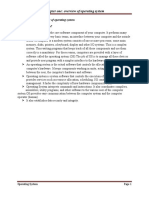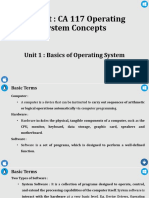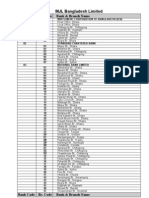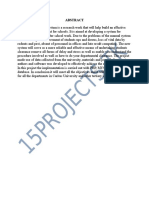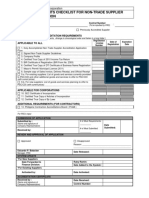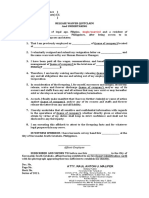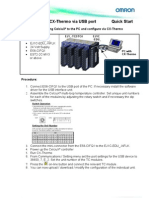9/16/24, 7:43 AM Functions of Operating System: Definition, Types of OS and Examples
Search for a topic SIGNUP LOGIN
LEARN
Home > Computer Science > Computer Fundamentals > Operating System > Functions of Operating System
EXAMS
Operating System
Functions
ASK of Operating System
Operating
CONCEPTS System
An operating system (OS) is a program that acts as an interface between the
system hardware and the user. Moreover, it handles all the interactions between
the software and the hardware. All the working of a computer system depends
on the OS at the base level. Further, it performs all the functions like handling
memory, processes, the interaction between hardware and software, etc. Now,
let us look at the functions of operating system.
Operating System
Objectives of OS
https://www.toppr.com/guides/computer-science/computer-fundamentals/operating-system/functions-of-operating-system/ 1/14
�9/16/24, 7:43 AM Functions of Operating System: Definition, Types of OS and Examples
The primary goals of an operating system are as follows:
Convenience – An operating system improves the use of a machine.
Operating systems enable users to get started on the things they wish to
complete quickly without having to cope with the stress of first
configuring the system.
Efficiency – An operating system enables the efficient use of resources.
This is due to less time spent configuring the system.
Ability to evolve – An operating system should be designed in such a
way that it allows for the effective development, testing, and
introduction of new features without interfering with service.
Management of system resources – It guarantees that resources are
shared fairly among various processes and users.
Functions of Operating System
1. Memory Management
It is the management of the main or primary memory. Whatever program is
executed, it has to be present in the main memory. Main memory is a quick
storage area that may be accessed directly by the CPU. When the program is
completed, the memory region is released and can be used by other programs.
Therefore, there can be more than one program present at a time. Hence, it is
required to manage the memory.
The operating system:
Allocates and deallocates the memory.
https://www.toppr.com/guides/computer-science/computer-fundamentals/operating-system/functions-of-operating-system/ 2/14
�9/16/24, 7:43 AM Functions of Operating System: Definition, Types of OS and Examples
Keeps a record of which part of primary memory is used by whom and
how much.
Distributes the memory while multiprocessing.
In multiprogramming, the operating system selects which processes
acquire memory when and how much memory they get.
2. Processor Management/Scheduling
Every software that runs on a computer, whether in the background or in the
frontend, is a process. Processor management is an execution unit in which a
program operates. The operating system determines the status of the processor
and processes, selects a job and its processor, allocates the processor to the
process, and de-allocates the processor after the process is completed.
When more than one process runs on the system the OS decides how and when
a process will use the CPU. Hence, the name is also CPU Scheduling. The OS:
Allocates and deallocates processor to the processes.
Keeps record of CPU status.
Certain algorithms used for CPU scheduling are as follows:
First Come First Serve (FCFS)
Shortest Job First (SJF)
Round-Robin Scheduling
Priority-based scheduling etc.
Purpose of CPU scheduling
https://www.toppr.com/guides/computer-science/computer-fundamentals/operating-system/functions-of-operating-system/ 3/14
�9/16/24, 7:43 AM Functions of Operating System: Definition, Types of OS and Examples
The purpose of CPU scheduling is as follows:
Proper utilization of CPU. Since the proper utilization of the CPU is
necessary. Therefore, the OS makes sure that the CPU should be as busy
as possible.
Since every device should get a chance to use the processor. Hence, the
OS makes sure that the devices get fair processor time.
Increasing the efficiency of the system.
3. Device Management
An operating system regulates device connection using drivers. The processes
may require devices for their use. This management is done by the OS. The OS:
Allocates and deallocates devices to different processes.
Keeps records of the devices.
Decides which process can use which device for how much time.
4. File Management
The operating system manages resource allocation and de-allocation. It
specifies which process receives the file and for how long. It also keeps track of
information, location, uses, status, and so on. These groupings of resources are
referred to as file systems. The files on a system are stored in different
directories. The OS:
Keeps records of the status and locations of files.
Allocates and deallocates resources.
https://www.toppr.com/guides/computer-science/computer-fundamentals/operating-system/functions-of-operating-system/ 4/14
�9/16/24, 7:43 AM Functions of Operating System: Definition, Types of OS and Examples
Decides who gets the resources.
5. Storage Management
Storage management is a procedure that allows users to maximize the
utilization of storage devices while also protecting data integrity on whatever
media on which it lives. Network virtualization, replication, mirroring, security,
compression, deduplication, traffic analysis, process automation, storage
provisioning, and memory management are some of the features that may be
included. The operating system is in charge of storing and accessing files. The
creation of files, the creation of directories, the reading and writing of data from
files and directories, as well as the copying of the contents of files and
directories from one location to another are all included in storage
management.
The OS uses storage management for:
Improving the performance of the data storage resources.
It optimizes the use of various storage devices.
Assists businesses in storing more data on existing hardware, speeding
up the data retrieval process, preventing data loss, meeting data
retention regulations, and lowering IT costs
What are the functions of Operating System
Security – For security, modern operating systems employ a firewall. A
firewall is a type of security system that monitors all computer activity
and blocks it if it detects a threat.
https://www.toppr.com/guides/computer-science/computer-fundamentals/operating-system/functions-of-operating-system/ 5/14
�9/16/24, 7:43 AM Functions of Operating System: Definition, Types of OS and Examples
Job Accounting – As the operating system keeps track of all the
functions of a computer system. Hence, it makes a record of all the
activities taking place on the system. It has an account of all the
information about the memory, resources, errors, etc. Therefore, this
information can be used as and when required.
Control over system performance – The operating system will collect
consumption statistics for various resources and monitor performance
indicators such as reaction time, which is the time between requesting a
service and receiving a response from the system.
Error detecting aids – While a computer system is running, a variety of
errors might occur. Error detection guarantees that data is delivered
reliably across susceptible networks. The operating system continuously
monitors the system to locate or recognize problems and protects the
system from them.
Coordination between other software and users – The operating
system (OS) allows hardware components to be coordinated and directs
and allocates assemblers, interpreters, compilers, and other software to
different users of the computer system.
Booting process – The process of starting or restarting a computer is
referred to as Booting. Cold booting occurs when a computer is totally
turned off and then turned back on. Warm booting occurs when the
computer is restarted. The operating system (OS) is in charge of booting
the computer.
Browse more Topics under Operating System
https://www.toppr.com/guides/computer-science/computer-fundamentals/operating-system/functions-of-operating-system/ 6/14
�9/16/24, 7:43 AM Functions of Operating System: Definition, Types of OS and Examples
Need for Operating System
Types of Operating System-Interactive (GUI Based)
Time Sharing
Real Time Operating System (RTOS)
Distributed Operating System
Commonly Used Operating System
Mobile OS
Types of Operating System
The operating system can be of different types. They are as follows:
1. Batch OS
In this system, the OS does not forward the jobs/tasks directly to the CPU. It
works by grouping together similar types of jobs under one category. Further,
we name this group as a ‘batch’. Hence, the name batch OS.
Examples are the payroll system, bank statement, etc.
2. Time-Shared OS
When more than one task takes place on the system it is called time-shared OS.
As multiple tasks can run at the system at a time as per requirement. Hence,
they all share the CPU time one by one. Therefore, we also name it
multitasking. The time that each task gets is called quantum.
A fixed interval of time is decided for each task. When the first task executes
for that period of time, the second task executes, and so on.
https://www.toppr.com/guides/computer-science/computer-fundamentals/operating-system/functions-of-operating-system/ 7/14
�9/16/24, 7:43 AM Functions of Operating System: Definition, Types of OS and Examples
Examples are UNIX etc.
3. Distributed OS
In this system, there is more than one CPU present. The OS distributes the tasks
among all the processors. The processors do not share any memory or clock
time. OS handles all communication between them through various
communication lines.
Examples are LOCUS etc.
4. Network OS
In these OS various systems are connected to a server. It allows the system to
share resources such as files, printers, applications, etc. Moreover, it gives the
capability to serve to manage these resources.
Examples are UNIX, LINUX, Microsoft Windows Server 2008, etc.
5. Real-Time OS (RTOS)
In these systems, the time interval for processing and responding to inputs is
very small. Therefore, due to this quality, these are used in real-time situations.
For example in missile systems, robots, etc.
They have two categories as follows:
a) Hard Real-Time Systems
In this, the time constraint is very short and strict. Even seconds of delay is not
acceptable.
b) Soft Real-Time Systems
https://www.toppr.com/guides/computer-science/computer-fundamentals/operating-system/functions-of-operating-system/ 8/14
�9/16/24, 7:43 AM Functions of Operating System: Definition, Types of OS and Examples
In this, the time constraint is not so short and strict.
Frequently Asked Questions (FAQs)
Q1. What is an OS?
A1. An operating system is a set of programs that acts as an interface between
computer hardware and user.
Q2. List the functions of OS.
A2. Functions of OS are:
Memory Management
Process Management/CPU Scheduling
Device Management
File Management
Security
Accounting
Error detection etc.
Q3. What are the types of operating systems?
A3. Major types of OS are:
Simple Batch OS
Multitasking/Time-shared OS
https://www.toppr.com/guides/computer-science/computer-fundamentals/operating-system/functions-of-operating-system/ 9/14
�9/16/24, 7:43 AM Functions of Operating System: Definition, Types of OS and Examples
Distributed OS
Network OS
Real-Time OS
Q4. What is CPU scheduling? Give examples.
A4. Every resource and application requires a processor. Therefore, when
multiple tasks are running on the system it is necessary to manage the CPU
time and usage. Hence, the OS keeps track of the CPU and allocates and
deallocates the CPU to devices and applications accordingly.
Examples of scheduling algorithms are:
First Come First Serve (FCFS)
Shortest Job First (SJF)
Round-Robin Scheduling
Priority-based scheduling etc.
Previous
Share with friends Next
Need for Operating System Types of Operating System-Interactive (GUI Based)
Customize your course in 30 seconds
Which class are you in?
https://www.toppr.com/guides/computer-science/computer-fundamentals/operating-system/functions-of-operating-system/ 10/14
�9/16/24, 7:43 AM Functions of Operating System: Definition, Types of OS and Examples
5 th 6 th 7 th 8 th
9 th 10 th 11 th 12 th
GET STARTED
Get ready for all-new Live Classes!
Now learn Live with India's best teachers. Join courses with the best
schedule and enjoy fun and interactive classes.
tutor tutor tutor
tutor tutor tutor
Ashhar Firdausi Dr. Nazma Shaik Gaurav Tiwari
IIT Roorkee VTU APJAKTU
Biology Chemistry Physics
GET STARTED
https://www.toppr.com/guides/computer-science/computer-fundamentals/operating-system/functions-of-operating-system/ 11/14
�9/16/24, 7:43 AM Functions of Operating System: Definition, Types of OS and Examples
Browse
Operating System
Commonly Used Operating System Distributed Operating System
Mobile Operating System Real Time Operating System (RTOS)
Time Sharing Operating System
Types of Operating System-Interactive (GUI Based) Functions of Operating System
Need for Operating System
Leave a Reply
Your email address will not be published. Required fields are marked *
Comment
Name *
Email *
Website
Post Comment
Browse
Operating System
Commonly Used Operating System
https://www.toppr.com/guides/computer-science/computer-fundamentals/operating-system/functions-of-operating-system/ 12/14
�9/16/24, 7:43 AM Functions of Operating System: Definition, Types of OS and Examples
Distributed Operating System
Mobile Operating System
Real Time Operating System (RTOS)
Time Sharing Operating System
Types of Operating System-Interactive (GUI Based)
Functions of Operating System
Need for Operating System
Download the App
Watch lectures, practise questions and take tests on the go.
Download Previous Years QUESTION PAPERS
Quick TIPS AND TRICKS for Successful Exam Preparation
Download NCERT Notes and Solutions
Learn from VIDEO lectures
CLASSES BOARDS EXAMS
CLASS 5 CBSE MADHYA PRADESH JEE MAIN NEET NTSE
https://www.toppr.com/guides/computer-science/computer-fundamentals/operating-system/functions-of-operating-system/ 13/14
�9/16/24, 7:43 AM Functions of Operating System: Definition, Types of OS and Examples
CLASS 6 ICSE MAHARASHTRA JEE ADVANCED AIIMS NSO
CLASS 7 IGCSE PUNJAB UPSEE AFMC NSTSE
CLASS 8 ANDHRA PRADESH RAJASTHAN BITSAT AP EAMCET KVPY
CLASS 9 BIHAR TAMIL NADU TS EAMCET COMEDK HBBVS
CLASS 10 GUJARAT TELANGANA WBJEE JIPMER IMO
CLASS 11 JHARKHAND UTTAR PRADESH VITEEE BCECE IEO
CLASS 12 KARNATAKA MHT-CET KCET IJSO
CLASS 12+ KERALA SAT KEAM NDA
About Us • Press • Customer Stories • Jobs • Educators • Blog • Bytes •
Contact Us • FAQs
Terms Of Service • Privacy Policy
https://www.toppr.com/guides/computer-science/computer-fundamentals/operating-system/functions-of-operating-system/ 14/14













